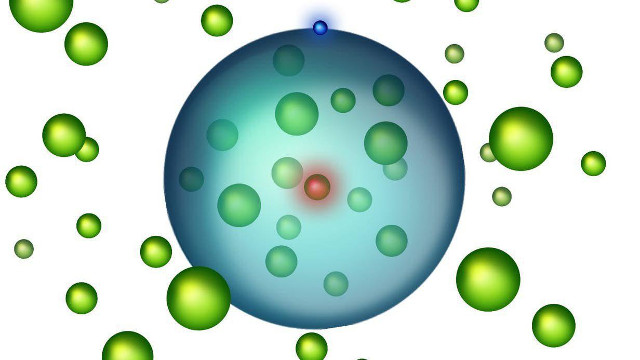'Giant atoms' swallow other atoms to create a new state of matter
As scientifically proven, there is always a relatively large empty space inside an atom. Now, scientists from Austria and the United States have filled some of these gaps, creating a new physical state in the form of "giant atoms" filled with other atoms.
Normally, there is a gap between the nucleus of an atom and the electrons orbiting it. The distance of that orbit depends on the type of atom and at a few hundred nanometers wide, in which the Rydberg atom is nicknamed the "giant atom". It is a thousand times bigger than the radius of a hydrogen atom, making researchers wonder if these giant atoms can "stuff" other small atoms.
 'Giant atoms' swallow other atoms to create a new state of matter Picture 1
'Giant atoms' swallow other atoms to create a new state of matter Picture 1
To test this idea, researchers from TU Wien, Rice University and Harvard began with a Bose-Einstein condensate. The strange state of this matter is formed when the atoms are slightly cooled, causing them to slow down and begin to gather together, exhibiting unusual movement. Recent Bose-Einstein concentrates have helped scientists create new exotic material states like super solid, excitonium and liquid with negative mass.
In this case, the starting point is a cloud of strontium atoms. After cooling them into Bose-Einstein condensate, the team used lasers to activate one of the atoms, bringing an electron in the atom into a high excited state. The excited electron began to orbit the nucleus at a greater distance than usual, creating the Rydberg atom.
The orbit of this electron becomes so large that other strontium atoms can easily fit inside it. The team observed that up to 170 atoms are in a Rydberg atom, this number may depend on the radius of the Rydberg atom and the Bose-Einstein density.
Atoms interact with each other, but very weak. The Rydberg atom's electromagnet is very small dispersed by neutral atoms in its path, but because the electron is too slow, it does not turn into another state.
The team ran a computer simulation of this interaction and found that this weak interaction reduced the system's total energy, forming a link between giant atoms and smaller particles within it. .
"Atoms don't carry electrical charge, so they only create a minimum force for the electron," said Shuhei Yoshida, co-author of the study. "This is a very unusual situation. Normally, we will encounter charged nuclei, electrons bound around them. Here, we have linked neutral atoms."
Joachim Burgdörfer, co-author of the study, said: "For us, this new state is an interesting ability to investigate the physics of ultracold atoms. In this way, one can explore. Bose-Einstein properties on very small scales with very high accuracy ".
This study is published in Physical Review Letters.
See more:
- Hydrogen bombs, nuclear weapons are 1,000 times more powerful than nuclear bombs
- The meteorite explosions in the sky of the Earth have more destructive power than the atomic bomb
- The photo series records unforgettable moments of world history
You should read it
- If the atomic bomb exploded in the ground, what horrible thing would happen?
- Dark matter, dark energy and unexplored mysteries
- Hydrogen bombs, nuclear weapons are 1,000 times more powerful than nuclear bombs
- Scientists have 'thrown' the atomic bomb into beer, soda and drank them
- The giant meteorite weighing 40 million tons caused a disaster equivalent to 65,000 atomic bombs about to crash into Earth?
- Meteors have the power to destroy 10 billion atomic bombs hitting the Earth at the 'super dangerous' angle, completely eliminating dinosaurs
- Physicists create matter with 'negative mass'
- Finding new materials capable of detecting dark matter
- Astronomers create the most accurate map of all matter in the universe
- This machine needs more turns to complete a cycle than the number of atoms in the universe
- Elements of the universe
- Scientists have finally discovered the mystery of dark matter in the universe
May be interested

Exotic ice diamonds have never been seen in nature

Life on Earth can be derived from cyanide

Entertainment on Neural Networks, Artificial Intelligence and Machine Learning

Wi-Fi on the plane and things you need to know before using

10 mysterious and strange places appear Google Earth that surprised people

What is N2O gas (laughing gas), how harmful is it?






 Giant pythons devoured goats and were caught
Giant pythons devoured goats and were caught Physicists create matter with 'negative mass'
Physicists create matter with 'negative mass' Watch the giant python swallow whole eyes for 10 seconds
Watch the giant python swallow whole eyes for 10 seconds Dark matter, dark energy and unexplored mysteries
Dark matter, dark energy and unexplored mysteries Official: We have a new physical state: time crystal
Official: We have a new physical state: time crystal Astronomers create the most accurate map of all matter in the universe
Astronomers create the most accurate map of all matter in the universe